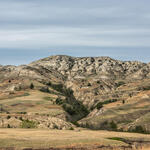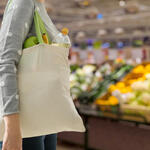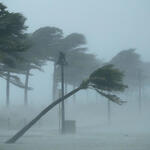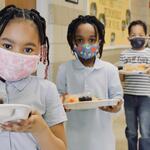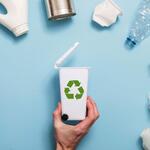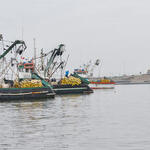- Date: 13 October 2021
- Author: Alexis Bonogofsky, Program Manager, WWF’s Sustainable Ranching Initiative
Bouncing around in Joe Russell’s pickup truck alongside my colleague Aaron, I am struck by eastern Montana’s vast sky and the varied topography. The state’s wide-open, undisturbed landscapes are some of its most special attributes and they are evidenced here on Joe’s 16,000-acre family ranch. The land here at Veebaray Cattle Company consists of badlands and deep woody draws, rising steeply into red, pink, and yellow hills. These add surprising color to an otherwise muted prairie palette.
The Veebaray Cattle Co, whose name comes from the phonetic sound of the ranch’s cattle brand (V-Bar-A), has been in business for 110 years. Joe wants his family to be in business for 110 more. He plans to accomplish this through good grass management and forward-thinking practices.
- Date: 13 October 2021
- Author: Tessa Bellone, WWF
In just a few decades, plastic has become ubiquitous in our everyday lives. The rapid rise of this lightweight and convenient material has supported critical services in our food and medical industries, helping advance society to where we are today. Yet despite its benefits, plastic waste is choking our planet -- polluting the water, air, and soil that people and wildlife need to survive. As this crisis spreads to every corner of the globe, we must reimagine how we source, design, dispose of, and reuse the plastic materials communities most depend on.
For ideas to solve today’s broken system, we can start by looking at the past. Before the explosion of single-use plastic, many services relied on the reuse of valuable materials to keep costs down. Think of the 19th century milkman -- collecting, refilling, and delivering an essential product to consumers using the same high-quality containers countless times. Modern refrigeration may have driven the milkman obsolete by the 1950s, however the concept of sustainable reuse systems deserves a second look today.
- Date: 06 October 2021
The recent IPCC report on the physical science basis of climate change could not have been clearer about the need for immediate action to address the crisis. With this report, there has been a heavy focus on the necessity to mitigate the emissions the world pumps into the atmosphere. Equally important, and not to be overlooked, should be the point that the effects of climate change are only going to intensify, and we have to do more to limit the vulnerability of coastal communities to these threats, particularly for those already on the front lines of the crisis.
- Date: 29 September 2021
- Author: Alex Nichols-Vinueza, Program Manager, Food Loss and Waste
With school back in session and in-person for many around the U.S., students and teachers are once again able to take part in hands-on classroom activities. To keep kids safe, feeding students looks a little different this year in many schools, with some moving lunch outdoors for as long as possible, or shifting away from cafeterias since eating requires taking off masks. But no matter where it’s held, lunch (and in some cases breakfast) is always an amazing opportunity for students and educators to discuss critical lessons about how what we eat impacts our planet, and how much food is wasted every year.
- Date: 27 September 2021
- Author: Cheryl Margoluis, Executive Director, CARE-WWF Alliance
On the surface, poverty, species decline, hunger, extreme weather events, gender inequality, pollution, access to education, and global pandemics may not seem to have much in common – beyond that they all have devastating impacts on people and communities. But studies show that habitat destruction, driven by urbanization, industrialized agriculture, and climate change, accelerates biodiversity loss and limits access to key natural resources. In turn, this threatens the way of life of many indigenous peoples and local communities who rely on forests, grasslands, soil and water for their livelihoods. Further, habitat destruction, and the expansion of livestock production are some of the largest identified drivers of zoonotic disease emergence. And when people get sick, it is harder to use natural resources sustainably and plan for the long term: money gets diverted to health costs rather than long term investments, like education or sustainable natural resource management. The complexity of these challenges becomes more apparent once you start connecting all the dots.
- Date: 24 September 2021
- Author: Marcene Mitchell, Senior Vice President, Climate Change, WWF
As Climate Week and the first ever UN Food Systems Summit (The Summit) come to a close in NYC, it is worth reflecting on the relationship between our climate crisis and our broken food system – and what we can do to fix them both.
The food system is responsible for about 21–37% of total greenhouse gas (GHG) emissions and agriculture is clearly implicated as the primary driver of land conversion. Roughly 40% of the world’s land that is not desert is now used for food production, and in addition to its climate footprint, land conversion to agriculture is also the primary cause of natural habitat and biodiversity loss.
As our global population grows, we convert more and more of our arable land to produce food for animals and people. At the same time, our food systems are not supporting our health and well-being, with approximately 3 billion people suffering from food-related maladies ranging from malnutrition to obesity.
Despite its impacts, agriculture is the only sector that has the ability to be part of the climate solution.
So how do we change our food system so that it is good for both our health and the health of the planet?
- Date: 22 September 2021
September 22, 2021 marks the eleventh annual World Rhino Day: a global celebration of an animal whose future has long been uncertain.
At the beginning of the 20th century, an estimated 500,000 rhinos roamed Africa and Asia. By 1970, rhino numbers dropped to 70,000—and today, around 27,000 rhinos remain in the wild.
Very few rhinos are able to survive outside national parks, reserves, and community conservation areas, as they remain under threat from poaching for their horns and from significant habitat loss and degradation.
Within these protected areas, rangers play a critical role—and, at times, represent the last line of defense standing between a species’ survival and their extinction.
- Date: 09 September 2021
Every day, plastic pollution is flowing into our natural environment at an unprecedented rate, with at least one dump truck every minute entering our oceans alone. It’s time to turn off the tap, together. We need everyone—industry leaders, policymakers, and everyday consumers—to play a role in transforming the broken systems by fixing how we source, dispose of, recycle, and reuse the plastics we need in our daily lives. The more we can coordinate these large-scale actions together, the more impactful we’ll be.
- Date: 01 September 2021
- Author: Stephanie Bradley, Director, Fisheries in Transition
History tells us that the best conservation tools in the world won’t make a bit of difference if people don’t know how to use them, and that makes education and training critical to protecting fish populations.
We’ve co-created a wide array of approaches to help the fishing industry transition to more environmentally sustainable practices and each approach requires something we often refer to as capacity building. In simpler terms, that’s making sure to invest in people who can put effective tools to use.
Now we’re making it easier for local stakeholders to learn how to use one of the most effective tools for ending overfishing and protecting the security of coastal communities dependent on fish resources.
Training comes before improvement
A fishery improvement project, or FIP, is a stepwise approach to improving fishing practices and management. These projects are taking place in every corner of the world, from small-scale efforts to large-scale projects. Right now, there are 157 FIPs around the world and World Wildlife Fund (WWF) is involved in 31 of them.
No matter the size, all FIPs follow the same approach—and it starts with learning.
WWF has reached more than 300 people as part of on-the-ground FIP training workshops that began in 2015. These seminars taught local stakeholders how to develop, implement, and monitor the progress of improvement projects. The sessions also include knowledge sharing on how best to communicate with and engage key partners, as well as how to develop funding strategies to support the financial needs of their projects.
We’ve been fortunate to have opportunities to hold these workshops in major fishing hubs—Asia-Pacific, Latin America, and the Caribbean—but training in-person is expensive, and it’s hard to accomplish with travel restrictions brought on by a global pandemic. That’s why we’ve invested in fostering virtual learning.
Reaching more people, faster
Even before the global health crisis, we started working with a group of partners to bring this training online. Now the knowledge and skills necessary to develop and implement FIPs are available to anyone, anywhere in the world.The program includes seven courses along with case studies to reinforce learning, a community forum space, and resources to help participants along the way—all available in both English and Spanish.
Since these projects leverage the power of the private sector’s purchasing power, this tool will help importers, processors, traders, and retailers too. We’ve heard from our partners in the seafood industry who plan to promote this tool as a cost-effective means for source fisheries to begin implementing improvement projects.
There’s no quick fix for unsustainable fishing. It takes a lot of work to implement a multi-stakeholder effort to address environmental challenges and promote responsible management practices in a fishery. But online training makes local capacity building faster and more efficient. That’s good for people, the planet, and the bottom line.
- Date: 31 August 2021
WWF always leads with science when tackling the world’s most pressing environmental issues to protect both people and the planet. Often this is grounded in existing methods and tried-and-true best practices. But sometimes we come across a unique problem that requires an equally novel solution, and we rely on innovative and original research to fill that gap. The ReSource Footprint Tracker is one of the ways we’re paving the way to measure plastic pollution—and with a new report, we’re showing exactly how it works.
